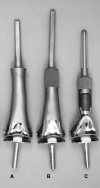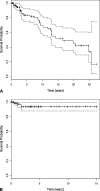Cemented distal femoral endoprostheses for musculoskeletal tumor: improved survival of modular versus custom implants
- PMID: 20033359
- PMCID: PMC2895832
- DOI: 10.1007/s11999-009-1197-8
Cemented distal femoral endoprostheses for musculoskeletal tumor: improved survival of modular versus custom implants
Abstract
Background: Advocates of newer implant designs cite high rates of aseptic loosening and failure as reasons to abandon traditional cemented endoprosthetic reconstruction of the distal femur.
Questions/purposes: We asked whether newer, modular distal femoral components had improved survivorship compared with older, custom-casted designs.
Patients and methods: We retrospectively reviewed 254 patients who underwent distal femoral endoprosthetic reconstruction. We excluded two patients with cementless implants, 27 with expandable prostheses, and 39 who had a nontumor diagnosis. This left 186 patients: 101 with older custom implants and 85 with contemporary modular implants. The minimum followup was 1 month (mean, 96.0 months; range, 1-336 months). The tumor was classified as Stage IIA/IIB in 122 patients, Stage IA/IB or benign in 43, and Stage III or metastatic in 21.
Results: Kaplan-Meier analysis revealed overall 10-, 20-, and 25-year implant survival rates of 77%, 58%, and 50%, respectively, using revision of the stemmed components as an end point. The 85 modular components had a greater 15-year survivorship than the 101 custom-designed implants: 93.7% versus 51.7%, respectively. Thirty-five stemmed components (18.8%) were revised for aseptic loosening in 22 patients, implant fatigue fracture in 10, infection in two, and local recurrence in one.
Conclusions: Cemented modular rotating-hinge distal femoral endoprostheses demonstrated improved survivorship compared with custom-casted implants during this three-decade experience. Patients with low-grade disease and long-term survivors of high-grade localized disease should expect at least one or more revision procedures in their lifetime.
Level of evidence: Level IV, therapeutic study. See the Guidelines for Authors for a complete description of levels of evidence.
Figures










References
-
- Bradish CF, Kemp HB, Scales JT, Wilson JN. Distal femoral replacement by custom-made prostheses: clinical follow-up and survivorship analysis. J Bone Joint Surg Br. 1987;69:276–284. - PubMed

